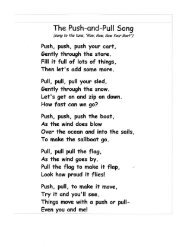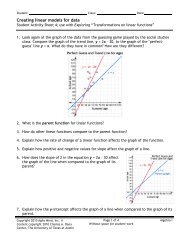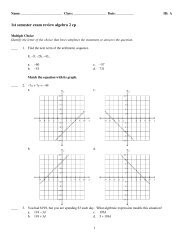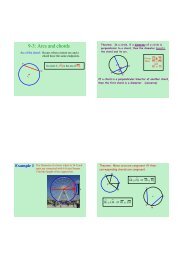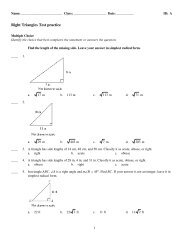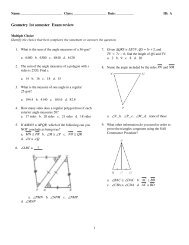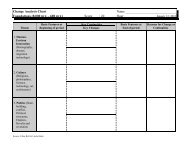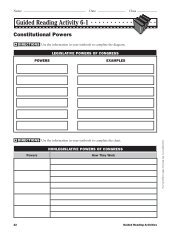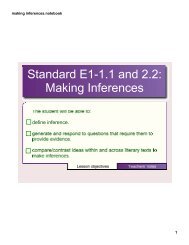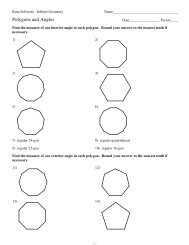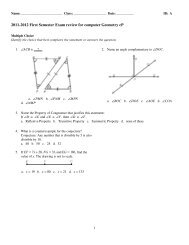Create successful ePaper yourself
Turn your PDF publications into a flip-book with our unique Google optimized e-Paper software.
WHY?<br />
ACTIVITY 02-1<br />
<strong>Atoms</strong>, <strong>Isotopes</strong>, <strong>and</strong> <strong>Ions</strong><br />
<strong>Atoms</strong> are the fundamental building blocks of all substances. To begin to underst<strong>and</strong> the properties<br />
of atoms <strong>and</strong> how they combine to form molecules, you must be familiar with their composition<br />
<strong>and</strong> structure.<br />
LEARNING OBJECTIVES<br />
• Underst<strong>and</strong> the composition <strong>and</strong> structure of atoms, isotopes, <strong>and</strong> ions<br />
• Underst<strong>and</strong> how atomic symbols <strong>and</strong> names identify the number of particles composing an<br />
atom, isotope, or ion<br />
SUCCESS CRITERIA<br />
• Use atomic symbols to represent different isotopes <strong>and</strong> ions<br />
• Given one or more of the following items, determine the others: name, atomic symbol, atomic<br />
number, mass number, neutron number, <strong>and</strong> electron number<br />
• Calculate the percent of the atomic mass that is located in the nucleus of an atom<br />
• Compare the size of an atom to the size of the atomic nucleus<br />
PREREQUISITES<br />
• Calculation of percent<br />
• Activity 01-1: Units of Measurement<br />
• Activity 01-2: Unit Analysis<br />
INFORMATION<br />
Matter, which is anything that has mass <strong>and</strong> occupies space, is composed of substances <strong>and</strong><br />
mixtures of substances.<br />
A substance, or more explicitly, a pure substance, is a variety of matter that has uniform <strong>and</strong><br />
constant composition. For example, pure water is a substance.<br />
Mixtures are composed of two or more substances. For example, salt water is a mixture, even<br />
though it is uniform, because the amount of salt in the water (the composition) can vary.<br />
An element is a substance that cannot be decomposed into two or more other substances by<br />
chemical or physical means. In nuclear reactions, however, one element can be converted into one<br />
or more other elements. Only about 118 different elements are known to exist.<br />
An atom is the smallest part of an element that can exist either alone or in combination with other<br />
atoms.<br />
<strong>Isotopes</strong> are atoms that have the same number of protons but different numbers of neutrons.<br />
An ion is an atom or molecule with a positive or negative charge.<br />
A cation is an ion with a positive charge.<br />
An anion is an ion with a negative charge.<br />
15
Foundations of Chemistry<br />
MODEL: SODIUM<br />
The diagrams below show representations of sodium. Note that the diameter of an atom is about<br />
10,000 times larger than the diameter of the atomic nucleus.<br />
Table 1 Subatomic Particles<br />
Particle Mass (amu)* Charge<br />
Proton 1.0073 +1<br />
Neutron 1.0087 0<br />
Electron 0.0005 –1<br />
* Atomic mass unit (amu) is a unit of mass equal to 1.66054 × 10 –27 kg.<br />
Atomic Symbol Notation<br />
A +<br />
X<br />
Z<br />
Mass Number<br />
Atomic Symbol<br />
Atomic Number<br />
Charge<br />
Figure 1<br />
Sodium-23<br />
23<br />
Na<br />
11<br />
Extremely small, dense nucleus<br />
with 11 protons <strong>and</strong> 12 neutrons.<br />
Diffuse cloud of 11 electrons.<br />
Sodium-24<br />
24<br />
Na<br />
11<br />
Extremely small, dense nucleus<br />
with 11 protons <strong>and</strong> 13 neutrons.<br />
Diffuse cloud of 11 electrons.<br />
Sodium-24 cation<br />
24 +<br />
Na<br />
11<br />
Extremely small, dense nucleus<br />
with 11 protons <strong>and</strong> 13 neutrons.<br />
Diffuse cloud of 10 electrons.<br />
KEY QUESTIONS<br />
1. What are the three particles that comprise a sodium atom?<br />
Protons, neutrons <strong>and</strong> electrons<br />
2. Which particles contribute most of the mass to the atom, <strong>and</strong> where are these particles located?<br />
Protons <strong>and</strong> neutrons, which are inside the nucleus at the center of the atom.<br />
16<br />
Chapter 2: <strong>Atoms</strong> <strong>and</strong> Elements
3. Which particles contribute most to the volume or size of the atom, <strong>and</strong> where are these particles<br />
located?<br />
Electrons, which are outside the nucleus.<br />
4. What information is provided by the atomic number, Z, which is the subscript in the atomic symbol?<br />
The number of protons<br />
5. What information is provided by the mass number, A, which is the superscript in the atomic<br />
symbol?<br />
The sum of the number of protons <strong>and</strong> number of neutrons.<br />
6. What notation is used in the atomic symbol to indicate the charge of an atom or ion?<br />
Plus signs (positive) or minus signs (negative), with numbers to indicate multiple charges (>1)<br />
are used as superscripts on the right side of the symbol.<br />
7. Given the definition of mass number <strong>and</strong> the information in Table 1 regarding the masses of<br />
protons, neutrons, <strong>and</strong> electrons, why is the mass number approximately, but not exactly equal to,<br />
the mass of an atom in amu?<br />
Protons <strong>and</strong> neutrons each have a mass very close to 1 amu, so counting the protons <strong>and</strong><br />
neutrons gives the mass number, which therefore is very close to the mass of the atom in<br />
amu.<br />
8. How is the charge of the atom or ion determined from the number of protons, neutrons, <strong>and</strong><br />
electrons present?<br />
Charge equals number of protons minus number of electrons. The number of neutrons doesn’t<br />
matter because they have no charge.<br />
9. What do all atoms <strong>and</strong> ions of sodium have in common?<br />
The same number of protons<br />
10. In general, what feature of an atom identifies it as a particular element?<br />
The number of protons<br />
11. In general, how do isotopes of the same element differ?<br />
Different isotopes have different numbers of neutrons.<br />
12. How many isotopes of any particular element could there be? What might prevent all of these<br />
isotopes from occurring naturally?<br />
From what we’ve seen in this activity, there could be an infi nite number of isotopes because<br />
any number of neutrons could be added to the nucleus of an atom. Not all these isotopes<br />
occur naturally because not all of them are stable.<br />
Note:<br />
An opportunity for student research projects is presented by this question. Have students identify<br />
the forces they think hold the nucleus together, <strong>and</strong> why a nucleus might become unstable<br />
once too many neutrons are present. They can also research isotopes in their textbooks or on<br />
the Internet <strong>and</strong> identify the characteristic neutron to proton ratios that lead to stable nuclides.<br />
Activity 02-1 <strong>Atoms</strong>, <strong>Isotopes</strong>, <strong>and</strong> <strong>Ions</strong> 17
EXERCISES<br />
Foundations of Chemistry<br />
1. Insert the missing information in the following table. The first row is completed for you to provide<br />
an example.<br />
Note: Shaded cells/numbers represent student answers.<br />
Table 2<br />
Name Symbol Z A<br />
boron-10<br />
10 +<br />
B<br />
5<br />
Number of<br />
Neutrons<br />
Number of<br />
Electrons<br />
5 10 5 4<br />
calcium-40<br />
40 2+<br />
Ca<br />
20<br />
20 40 20 18<br />
oxygen-16<br />
16<br />
8<br />
O<br />
8 16 8 8<br />
uranium-238<br />
238<br />
92<br />
U<br />
92 238 146 92<br />
fluorine-19<br />
19<br />
9<br />
F<br />
9 19 10 9<br />
chlorine-35<br />
35 –<br />
Cl<br />
17<br />
17 35 18 18<br />
potassium-39<br />
39<br />
19<br />
K<br />
19 39 20 19<br />
2. Show how to calculate the mass of a proton, neutron, <strong>and</strong> electron in kilograms using the data in<br />
Table 1 <strong>and</strong> the equality statement: 1 amu = 1.66054 × 10 -27 kg<br />
proton:<br />
<br />
1.66054 10 kg<br />
-27<br />
1.0073 amu 1.6727 10 kg<br />
1 amu<br />
-27<br />
<br />
neutron:<br />
electron:<br />
<br />
1.66054 10 kg<br />
-27<br />
1.0087 amu 1.6750 10 kg<br />
1 amu<br />
<br />
1.66054 10 kg<br />
-31<br />
0.0005 amu 8 10 kg<br />
1 amu<br />
-27<br />
-27<br />
<br />
<br />
18<br />
Chapter 2: <strong>Atoms</strong> <strong>and</strong> Elements
PROBLEMS<br />
1. The mass of a carbon-12 atom is 12 amu. What percent of the mass is located in the nucleus? Why<br />
is the value you calculated so close to 100%?<br />
percent mass in nucleus =<br />
mass of nucleus 100<br />
mass of atom<br />
mass of nucleus = mass of atom – mass of electrons<br />
<br />
12 amu - (6 0.0005 amu) 100<br />
12 amu<br />
<br />
<br />
99.975%<br />
The value calculated is very close to 100% because the electrons not in the nucleus have a<br />
very small mass compared to the protons <strong>and</strong> neutrons.<br />
Note 1: The students should now underst<strong>and</strong> that almost 100% of the mass of an atom is in its nucleus.<br />
Note 2: Students might calculate the percent mass located in the nucleus by adding the mass of six<br />
protons <strong>and</strong> six neutrons. Their answer then will be that 100.8% of the mass is located in<br />
the nucleus. This result presents the opportunity to emphasize the importance of validating<br />
answers.<br />
Ask some questions. Is it possible for more than 100% mass to be in the nucleus? Is there<br />
another way to answer the question by considering the mass of the electrons? After they get<br />
the correct answer <strong>and</strong> realize it makes more sense, discuss with them the binding energy<br />
between protons <strong>and</strong> neutrons <strong>and</strong> the equivalence of mass <strong>and</strong> energy as expressed by<br />
Einstein’s equation E = mc 2 . The binding energy explains why the sum of the masses of the<br />
protons <strong>and</strong> neutrons in the nucleus is greater the mass of the nucleus.<br />
Alternatively, students could be asked to research this issue <strong>and</strong> report to the class next<br />
session on why the sum of the masses of the protons <strong>and</strong> neutrons is larger than the mass of<br />
the nucleus.<br />
Activity 02-1 <strong>Atoms</strong>, <strong>Isotopes</strong>, <strong>and</strong> <strong>Ions</strong> 19
Foundations of Chemistry<br />
2. The radius of a Cl nucleus is 4.0 fm, <strong>and</strong> the radius of a Cl atom is 100 pm. If the nucleus of the<br />
Cl atom were the size of a dime, which is 17 mm in diameter, determine whether the atom would<br />
be approximately a) the size of a quarter, b) the size of a car, c) the size of a football stadium, or<br />
d) the size of the earth. Explain how you made your decision.<br />
Radius of a Cl nucleus is 4.0 fm, which is 4.0 × 10 -15 m.<br />
Radius of a Cl atom is 100 pm, which is 100 × 10 -12 m.<br />
Compare the ratios:<br />
atom x<br />
<br />
nucleus dime<br />
100 10<br />
410<br />
-12<br />
-15<br />
x<br />
<br />
17mm<br />
3 1 m <br />
x = 425 10 mm = 425 m<br />
1000 mm <br />
Which of the items has a diameter of approximately 425 meters?<br />
It is reasonable that a football stadium’s size is 425 m. The other choices can be ruled out:<br />
The size of a quarter <strong>and</strong> a car are smaller than 425 m, <strong>and</strong> the size of the Earth is much<br />
larger.<br />
Note:<br />
If students do not know where to begin, you can ask them to draw a sketch of the atom showing<br />
the nucleus, <strong>and</strong> a dime surrounded by one of the objects listed in the question. Then ask<br />
them if they see by looking at their sketch how they can compare the sizes. If more direction is<br />
needed, ask if taking ratios would be helpful.<br />
20<br />
Chapter 2: <strong>Atoms</strong> <strong>and</strong> Elements




